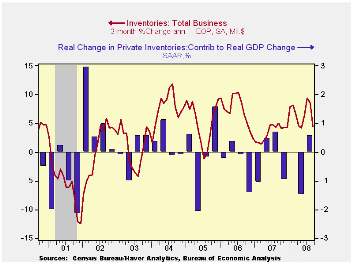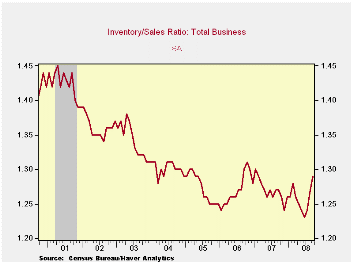 Global| Nov 14 2008
Global| Nov 14 2008U.S. Business Inventory Accumulation Waned
by:Tom Moeller
|in:Economy in Brief
Summary
During September, total business inventories reversed all of their August rise and fell 0.2%. The decline was weaker than Consensus expectations for no change. More importantly, however, it could suggest that the addition to 3Q GDP [...]

During September, total business inventories reversed all of their August rise and fell 0.2%. The decline was weaker than Consensus expectations for no change. More importantly, however, it could suggest that the addition to 3Q GDP growth of 0.6 percentage points from faster inventory accumulation waned as the quarter progressed. As of September the three-month growth in inventories fell to 4.4% (AR) from roughly 6.5% during the prior two quarters.
Normally, the suggestion of less of a contribution would be a sure thing. But these are not normal times given the drop in oil prices. Lower oil prices have dramatically reduced the value of inventories held by retailers, wholesalers and manufacturers.
Retail inventories rose 0.2% in September after a 0.7% August decline. The three-month growth rate of retail inventories picked up to 3.4% from 0.1% during 2Q. Accumulation of automobiles accounted for that increase rising at a 3.5% rate last quarter versus a decline of 5.7% during 2Q. Outside of autos, retail inventories rose 0.4% during September after a 0.2% August decline. The 3.3 rate of accumulation last quarter was roughly the same as during 2Q.
The industry detail in the retail sector indicated that higher apparel inventories contributed with a 3.1% rise last quarter versus 0.2% decumulation during 2Q. Furniture inventories rose at a 7.4% rate last quarter, about the same as during 2Q, and general merchandise inventories showed virtually zero growth after a 2.0% gain during 2Q. The fastest rate of accumulation came from building materials which ran up last quarter at a 13.1% rate after slight 2Q decumulation.
Factory inventories declined 0.7% during September and the three-month rate of accumulation fell sharply to 2.2% from a 7.4% rate during 2Q.
Wholesale inventories slipped 0.1%, largely reflecting a 3.5% decline in petroleum inventories. For the quarter wholesale inventories rose at an 8.6% rate after a 13.4% 2Q increase.
Total business sales fell 2.0% during September, about as they did in August, led lower by the drop in oil prices.
Today's speech by Fed President Ben S. Bernanke titled Policy Coordination Among Central Banks can be found here.
| usiness Inventories | September | August | Y/Y | 2007 | 2006 | 2005 |
|---|---|---|---|---|---|---|
| Total | -0.2% | 0.2% | 5.5% | 3.8% | 5.9% | 6.0% |
| Retail | 0.2% | -0.7% | 0.5% | 2.6% | 3.5% | 2.3% |
| Retail excl. Auto | 0.4% | -0.2% | 2.2% | 2.7% | 4.9% | 3.9% |
| Wholesale | -0.1% | 0.6% | 9.7% | 5.5% | 8.3% | 7.3% |
| Manufacturing | -0.7% | 0.7% | 7.0% | 3.7% | 6.4% | 8.9% |
Tom Moeller
AuthorMore in Author Profile »Prior to joining Haver Analytics in 2000, Mr. Moeller worked as the Economist at Chancellor Capital Management from 1985 to 1999. There, he developed comprehensive economic forecasts and interpreted economic data for equity and fixed income portfolio managers. Also at Chancellor, Mr. Moeller worked as an equity analyst and was responsible for researching and rating companies in the economically sensitive automobile and housing industries for investment in Chancellor’s equity portfolio. Prior to joining Chancellor, Mr. Moeller was an Economist at Citibank from 1979 to 1984. He also analyzed pricing behavior in the metals industry for the Council on Wage and Price Stability in Washington, D.C. In 1999, Mr. Moeller received the award for most accurate forecast from the Forecasters' Club of New York. From 1990 to 1992 he was President of the New York Association for Business Economists. Mr. Moeller earned an M.B.A. in Finance from Fordham University, where he graduated in 1987. He holds a Bachelor of Arts in Economics from George Washington University.






